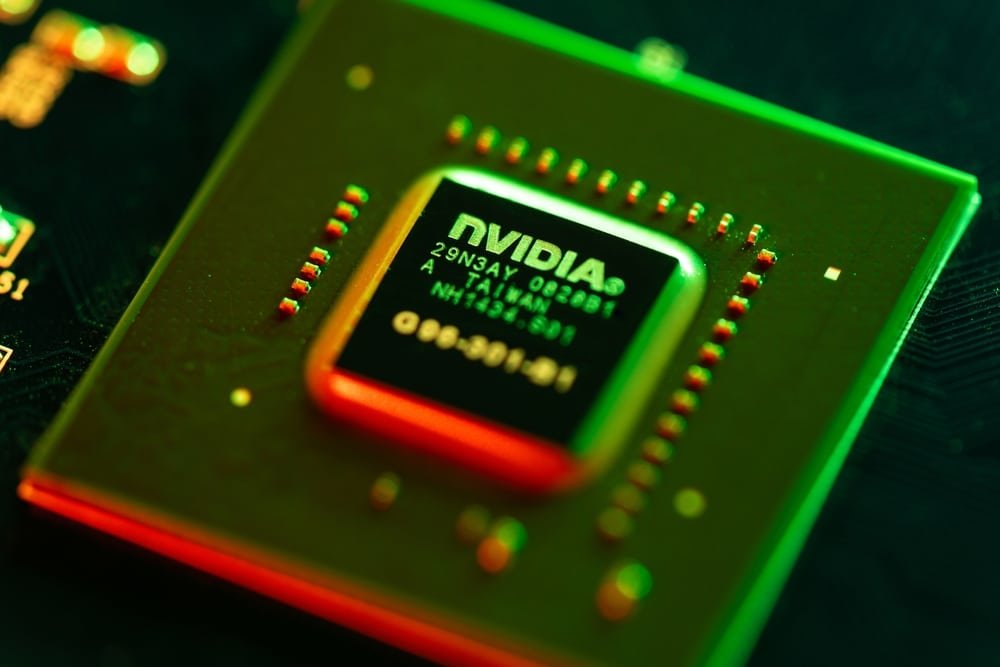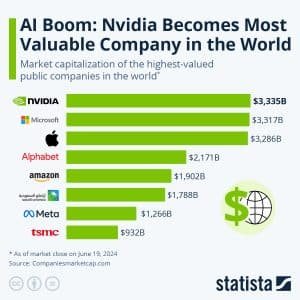Nvidia, a leading chipmaker, has seen an extraordinary rise in market value, surpassing Microsoft and Apple, driven by its dominance in AI and accelerated computing. As Nvidia’s stock soars, the energy demands of AI have brought one clean energy into focus as a critical solution for sustainable growth: nuclear power.
Nvidia’s Meteoric Rise and Net Zero Game
In May last year, Nvidia, valued at about $750 billion, announced its first fiscal quarter results for 2024. Revenue grew by 19%, and net income rose by 26%, showing positive but not exceptional performance. What stirred excitement was Nvidia’s forecast for the next quarter, predicting a 65% revenue increase.
CEO Jensen Huang highlighted the company’s leadership in accelerated computing and generative AI, predicting a significant shift in global data center infrastructure towards these technologies. Investors interpreted this as Nvidia seizing a trillion-dollar opportunity, driving its stock price to record highs.
The following day, Nvidia’s market cap surged by nearly $200 billion, marking the start of an unprecedented rally. By June 2023, Nvidia’s market cap surpassed $1 trillion, reaching $2 trillion on March 1, 2024, and surpassing $3 trillion just over three months later. Recently, after a stock split, Nvidia’s market cap at $3.34 trillion, soared past Microsoft and Apple, making it the world’s most valuable company.
Nvidia’s standout metrics include its high gross margin of 78.4% in the latest quarter, compared to 46.6% for Apple and 70.1% for Microsoft. Moreover, Nvidia’s revenue growth over the past year was remarkable at 208%, contrasting with Apple’s 1% decline and Microsoft’s 14% growth, according to Statista.
While investors enjoyed this quick ascent, questions remain about whether Nvidia’s current high valuation would be long-term. More so, some environmental critics are questioning the company’s climate commitments and net zero targets.
In Nvidia’s FY2023 Corporate Responsibility Report, the company outlines its key sustainability goals and metrics:
- By the end of fiscal year 2025, and annually thereafter, Nvidia aims to achieve and maintain 100% renewable electricity for its offices and data centers under its operational control.
- Nvidia’s Blackwell GPUs, introduced in March 2024, are reported to be generally 25x more energy-efficient than traditional CPUs for certain AI and high-performance computing (HPC) workloads.
- Nvidia technologies currently power 23 of the top 30 systems on the latest Green500 list.
Apart from these, however, there’s no clear net zero strategy outlined in the chipmaker’s report, only Nvidia’s greenhouse gas emissions.
The Environmental Footprint of AI and Chips
Some believe Nvidia is poised at the forefront of the AI boom. And as AI capabilities improve and expand, so does its need for energy to fuel its exponential rise.
Notably, the environmental impact of using chips is well-documented. Researchers from Lancaster University estimate that information and communications technologies, including data centers, contribute between 1.8% and 2.8% of global greenhouse gas emissions.
The International Energy Agency predicts that the sector’s electricity consumption could double from 2022 to 2026, reaching 4% of global demand, equivalent to Japan’s current energy use. This rising demand has slowed the retirement of coal-fired power plants, according to Bloomberg.
Less understood is how to mitigate the energy and environmental impact of manufacturing advanced chips used in data centers and large AI models.
A chip’s carbon footprint spans its entire production chain, from mining essential metals to using 1000-degree Celsius ovens during fabrication, and its energy use throughout its lifespan.
Advanced chips, which feature wires as thin as 10 nanometers (one-thousandth the diameter of a human hair), require high-energy photons with short wavelengths for fabrication. State-of-the-art lithography processes contribute significantly to the carbon footprint of modern computing.
In an analysis by Gage Hills, Assistant Professor of Electrical Engineering at Harvard John A. Paulson School of Engineering and Applied Sciences, the energy needed to manufacture a computer chip can surpass the amount it consumes over its entire 10-year lifespan.
Great Power Comes Great Energy Demand
The excitement around AI has further intensified, alongside projections that global spending on AI will exceed $300 billion by 2027. This surge has reignited interest in renewable energy sources to address the soaring demand for power while keeping environmental impact in mind.
More remarkably, it thrust nuclear power into the spotlight as a viable, clean energy source capable of meeting the immense energy demands of making chips and AI infrastructure. The U.S. nuclear fleet would play a crucial role in meeting these rising power needs by 2030.
-
In Texas alone, data centers have requested the equivalent energy output of 41 nuclear power plants to sustain their operations.
Silicon Valley giants such as Microsoft’s Bill Gates, Amazon’s Jeff Bezos, and numerous venture capital firms have invested in nuclear startups to support their data center operations. OpenAI’s CEO, Sam Altman, underscored the urgency, describing a “desperate need for as much energy as we can manufacture.”
Investors eyeing opportunities in AI typically focus on ETFs containing semiconductor, cloud computing, and cybersecurity firms. However, they also have huge interest in utilities operating nuclear power plants and shares linked to nuclear power generation and its fuel uranium.
Nuclear power’s appeal lies in its ability to provide compact, reliable, weather-independent electricity through fission, making it ideal for powering AI data centers. This demand is boosting uranium prices worldwide as supply struggles to keep pace.
These developments promise to redefine nuclear energy’s role in the global energy landscape, potentially aiding in significant decarbonization efforts.
Nvidia becoming the world’s most valuable company is further lifting nuclear power up to match the energy demand of the chipmaking industry. Yet, the world is also waiting when, or if, Nvidia will share its net zero strategy.


